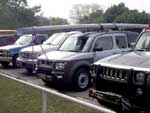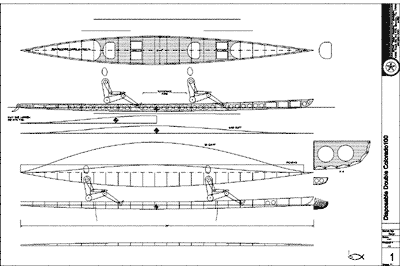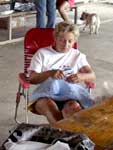Colorado River 100 Boat
design by Milton "Skip" Johnson
Postmortem – The skinny on a skinny skin boat
(click here for original article)

(click images to enlarge) |
Countless generation of Aleuts can’t be completely wrong but then they don’t live along the Texas Gulf coast. This skin boat had a few difficulties in the shallow rocky waters of the Colorado River. The skinny part is subject to interpretation too. Several people had commented about the long sleek boat hanging far out over both ends of my little Honda Element at sign in for the Colorado 100 when one of the Texas canoe racers took a good look at it and said “damn Skip, you could stand up in that boat”. Actually, I couldn’t stand up in it, but Dave probably could. At 28” maximum beam however, I could sit comfortably for hours on end and not worry about turning over.
This was a boat intended for a fairly narrow specific purpose. Carry two not so young guys (56 & 62) through a 100-mile Adventure canoe race down the Colorado River with a minimum of effort and hassle. Secondarily it needed to be cheap and easy to build. The design did a pretty good job on the first part, but the secondary criteria didn’t quite meet the challenge out on the river.

We didn’t make the full 100 miles but it wasn’t a boat issue. We pulled out at the Lagrange checkpoint after traveling some 62 miles in 11 hours. We were still moving well but slowing down a bit. Chuck’s hands had blistered up and he was starting to feel pretty used up so we decided it was prudent to call it a day rather than risk getting hurt in the night run. We averaged 5.6+ mph for the distance and ran 6+ mph on the river, spending about an hour or so stopped. The stops included two water pickups (Smithville and Plum Park) and a number of short stops to refill water jugs, punch card at check points (we missed one) and most importantly for me to pee and stretch.
Designwise the boat met the criteria well, we paddled steadily at a much slower rate than the boats we followed and the boat was easy to control in the riffles and sweepers we ran through. The only problems we had in these areas were due to operator error or lack of judgment. Fortunately these were few and far between since we usually had somebody with more skill and experience to follow, particularly at Buffalo Wallow Rapids. The only shortcomings we had besides the covering were minor. The primary fault in the conception was not having any real provision to move the paddlers fore and aft. The foamed seat pads worked well, would have been better with another layer of cushioning. But our feet were pretty well nailed into place and the boat would have been happier if we had been an inch or two further forward. We rearranged our supplies to bias the weight forward and that helped, but more adjustment would have been good. Also needed is some mechanism to pump the footwells dry while paddling. The only other minor detail that was a bit of an aggravation is I placed the switch for the bilge pump where I thought I could easily switch it on and off with my paddle and where it was easy to install. Should have spent the extra effort to mount the switch closer to hand.
The skin; let me count the ways. First there is no comparison between polyethylene (maybe 6,000 psi tensile strength on a good day) and polyester (25,000 psi tensile strength). The original ‘shrink-wrap’ film is fine for its intended purpose as a winter cover but is not near tough enough for a marathon canoe hull, even flatwater. The Dacron polyester fabric covering worked pretty well but still isn’t tough enough in some situations involving rocks (witness the 2 - 4” long gashes in the bottom, one being held together literally by a thread). It was still a fairly quick and dirty build. The basic flat top sit on top skin on frame style boat would be OK for a canoe/kayak that lead a fairly sheltered life but it is just too fragile for some venues.
Actual frame building was quick, serendipitously so, since I didn’t start building the boat until 2 months before the race.
|
|
|
Cutting out all the little pieces went even quicker than I’d expected. Good thing it was quick, because I hadn’t thought seriously about the seemingly infinite number of lineal feet of epoxy/wood flour fillets. I was also surprised at how flimsy the whole assembly was until it all got together. There was still some flex when all was done but it seemed to do all right in the water. |
The boat never really got a name (I was leaning towards “Geezermobile”), but served its function well. It was a lot of boat for two sheets of underlay ply and scrap. The most expensive item in the boat outside the two skins was the 1/8” braided spectra rudder cables. There was no strongback or form used, just stuck together sitting on a pair of fairly level sawhorses.
|
|
A laser level with a vertical beam borrowed from my son helped get the assembly fairly straight. Anyone contemplating building a skin on frame boat should consider getting a small spray or touch up gun. I can’t imagine the time required to finish a frame like this with a brush.
|
The first skin was a disaster, the second less so. Besides low tensile strength, polyethylene melts at just about the same temperature as the heat bond adhesives working temperature. It did shrink real well though. |
The second polyester skin, Ceconite from Aircraft Spruce, was attached with Ceconite cement and went well including double covering the bottom, bonding the two layers with heatbond film(image50s). Still it took more than 6 coats of paint to seal fairly well and ripped a couple of 4” long gashes sliding over a well placed rock(rip).
|
|
In the first outing on the ‘less than auspicious’ practice run to Smithville I was pretty disappointed in the rudder and was prepared to retract a lot of my comments in the design brief. But with a little better trim, hinges and rudder throw, the rudder worked magnificently. Several times I lost focus or made bad decisions about route but when I stepped on a rudder pedal the boat turned right then without any noticeable drop in speed. Not bad for a twenty-four foot long boat and some scrap pieces of Lexan, acm and aluminum. Don’t think there is anything I’d change about the rudder but I am planning to try another blade and a tilted hinge configuration before I retire/dispose of the boat. Anyone interested in a great deal on a low mileage twenty-four foot sit-on-top skin-on-frame kayak, please contact me.
Wouldn’t change the rudder and wouldn’t change much if anything about the shape, but if I ever do another similar boat it won’t be skin-on-frame. What it’ll be I’m not sure. I’m still a little burned out on wood strip construction and have got another one to build for a friend but at least its not a gold plater. The competitive racers are graduating to high-tech foams and fabrics like Colin Grimshaws GoldenSpear. I think I’ll make some samples and cogitate on blue Styrofoam and knitted eglass. In the fullness of time.
Errata
 my wife Susie
my wife Susie |
First and most important, Chuck and I owe an enormous debt of gratitude to our spouses for their active indulgence of our obsession. Heartfelt thanks.
Chuck hadn’t ever done anything remotely resembling this adventure before. We both trained regularly and made as many practice runs together as we could. Considering I started building the boat nine whole weeks before the race and we live 280 miles from each other two was all we could do. Chuck did a yeoman’s job of paddling setting a steady pace and never missing a stroke. I know he was concerned about pulling out of the race at Lagrange but I have a real hard time finding any fault with a run of 62 miles in 11 hours
The Colorado River 100 is a new venue (this is second year) and is a welcome addition to Texas Canoe Racing. The Texas Water Safari (World’s toughest boat race) has understandingly dominated the Texas canoe racing scene for over 40 years now, but it is nice to have an event not quite so extreme. Mike Drost and all the volunteers are to be commended; it was a well-run event.
Last and certainly least I’ve developed a new appreciation for Eveready Energiser Alkaline ‘D’ cells. The bilge pump, an Atwood 500 GPH model, ran continuously for 11 hours and still had quite a bit juice left, far better than the generic store brand I’d used previously.

